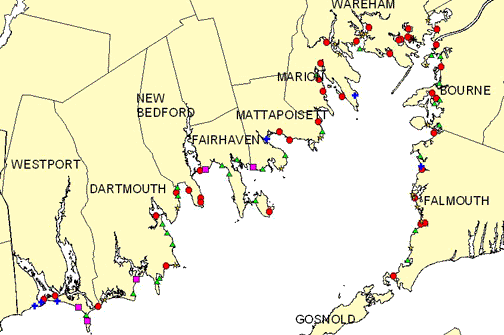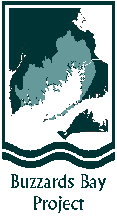We have 300 pages,
so try our
|
|
|
Bouchard 120 Oil spill Information on Buzzards Bay Beaches
All public sandy swimming beaches have been cleared of oil. No Town or State beaches are closed due to oil. Some oil may be on rocks and jetties, and residents are cautioned to stay off these areas. Occasional tar balls (pea size to hand size lumps) may occasionally appear in some areas (mostly in the vicinity of heavily oiled sites). Oil on skin can be removed with baby oil. Information packets will be available at beaches that were heavily oiled.
Go to our Health Issues page for more information on No. 6 oil toxicity.
General Beach Information
 Barnstable County Beach Results Postings Barnstable County Beach Results Postings
 July 2002 Announcement: Buzzards Bay Project provides Free Water Quality Testing July 2002 Announcement: Buzzards Bay Project provides Free Water Quality Testing
Looking for information on the annual Buzzards Bay Swim? Then visit the Coalition for Buzzards Bay web page.
Where do people swim in Buzzards Bay? Well on any hot summer day, you will find many beachfront property owners on their private beaches, but more likely residents will be swimming at one of the public beaches or resident association beaches in the map shown below.

Buzzards Bay Beaches (click on map for more detail)
NEW BEACH MONITORING REQUIREMENTS FOR PUBLIC AND SEMI-PUBLIC BEACHES IN MASSACHUSETTS
PROMULGATED APRIL 2001
As late as April 2001 in Massachusetts, under Chapter 111 of the Massachusetts General Laws, the Massachusetts Department of Public Health regulations (105 CMR Section 445) required that bathing beach samples be taken at least twice monthly during the bathing season. These regulations had also failed to spell out any objective standard requiring beach closure, and instead state "A [total] coliform count of 1000 per 100 ml shall be considered a guide requiring additional investigation, survey or special analyses as may be necessary."
All this changed last April when new regulations were issued requiring weekly testing, and a new bacterial standard for public and semi-public beaches. Semi-public beaches are those operated by trailer parks, camp grounds, motels, condiminiums, clubs, and similar entities. Some Highlights of these regulations:
445.031: Indicator Organisms
(A) For marine water, the indicator organism shall be Enterococci.
(1) No single Enterococci sample shall exceed 104 colonies per 100 ml. and
the geometric mean of the most recent five (5) Enterococci levels within the
same bathing season shall not exceed 35 colonies per 100 ml.
(B) For fresh water, the indicator organisms shall be E. Coli or Enterococci.
(1) No single E. Coli sample shall exceed 235 colonies per 100 ml. and the
geometric mean of the most recent five E. Coli samples within the same bathing
season shall not exceed 126 colonies per 100 ml; or
(2) No single Enterococci sample shall exceed 61 colonies per 100 ml. and the
geometric mean of the most recent five (5) Enterococci samples within the same
bathing season shall not exceed 33 colonies per 100 ml.
(C) Frequency.
(1) The Board of Health, its agent, or any other authorized person shall collect
the bacteriologic samples:
(a) Within five days of the opening of the bathing season; and
(b) At least weekly during the bathing season at a time and day
approved by the Board of Health or the Department; and
(c) Prior to reopening a beach after closing for any reason.
(2) Testing for oil, hazardous materials, or heavy metals shall only be required if
the operator, the Board of Health, or the Department has information indicating
possible contamination of the bathing beach or bathing waters from oil,
hazardous materials or heavy metals.
445.035: Sampling and Analysis at Semi-Public Beaches
(A) The operators of semi-public bathing beaches shall pay for the costs of testing,
monitoring and analysis of bathing waters adjacent to such semi-public bathing beaches.
445.040: Posting and Reopening Notifications
(A) Posting. Whenever the bathing water quality does not meet the requirements of 105
CMR 445.030 or after any significant rainstorm at a bathing beach where there has
been a history of violations of the water quality requirements contained in 105 CMR
445.030, the Board of Health, its agent, or any other authorized person shall
immediately, and in no event later than 24 hours, notify the Department, and post or
cause to be posted, a sign, or signs, at the entrance to each parking lot and each
entrance to the beach stating:
WARNING! NO SWIMMING
SWIMMING MAY CAUSE ILLNESS
and a graphic depiction of a swimmer in a red circle with a diagonal hatch mark. The
sign shall also contain the reason for the warning, the date of the posting and the name
and telephone number of the board of health.
The complete new DPH regulations (105 CMR 455) Spring 2001
DPH letter to Boards of Health in Spring 2001
And are the town's complying? Towns are required to submit data to DPH each October. It does not appear all Buzzards Bay town's have complied with the new requirements for testing frequency and reporting. The Buzzards Bay Project is now working with Buzzards Bay municipalities to achieve 100% compliance in 2002.
OTHER CONTAMINANTS RELATED TO HUMAN HEALTH
Massachusetts DPH Mercury & PCB advisories and DMF shellfish bed closures
Restrictions on pesticides in Zone 2s (public water supply recharge areas)
 What is the "Geometric Mean" and how to calculate it (used for swimming beach and shellfish bed closures) What is the "Geometric Mean" and how to calculate it (used for swimming beach and shellfish bed closures)


|

 Barnstable County Beach Results Postings
Barnstable County Beach Results Postings